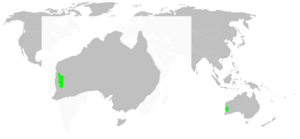Black rugose trapdoor spider facts for kids
Quick facts for kids Black rugose trapdoor spider |
|
|---|---|
| Scientific classification | |
 |
The Idiosoma nigrum, also known as the black rugose trapdoor spider, is a special spider found only in southwestern Australia. It lives in dry woodlands, mainly east of the Darling Scarp and north towards the Moore River.
Female spiders can grow to about 30 mm long, while males are smaller, reaching about 18 mm. These spiders dig burrows that can be up to 32 cm deep.
Contents
What's in a Name?
The name Idiosoma nigrum comes from the Latin word Niger, which means "black". This is likely because of the spider's dark color.
Spider Life and Habits
The black rugose trapdoor spider is perfectly suited for living in dry areas. They dig deep burrows, up to 32 cm, to stay safe and cool.
Clever Hunting Tricks
These spiders are smart hunters! They don't just wait at their burrow entrance. Instead, they arrange leaves and twigs in a circle around their burrow. These twigs act like "trip-lines." When an insect or other small animal touches a twig, the spider feels the movement. This tells the spider that food is nearby.
Once alerted, the spider quickly rushes out of its burrow to catch its prey. They mainly eat ants, but also enjoy beetles, cockroaches, millipedes, and moths. This "twig-line" method helps the spider find more food over a larger area.
Amazing Spider Armor
The black rugose trapdoor spider has a very thick outer skin, called a cuticle. This thick skin works like a strong armor to protect the spider.
Their burrow has a clever defense system too. A few centimeters below its thin, flat door, the burrow suddenly gets much narrower. If a predator like a scorpion, centipede, hunting wasp, or even a bird tries to get in, the spider drops head-first into this narrow part. It then uses its hard, shield-like abdomen to block the burrow entrance. This defense often makes predators give up and leave.
However, some special parasitic wasps have found a way around this defense. These wasps have very thin bodies and long, thin egg-laying tubes. They can slide their tubes into the small grooves on the spider's abdomen. This allows them to lay their eggs on the spider's softer skin. When the wasp larva hatches, it can safely start eating the spider alive.
The spider's thick cuticle also helps it survive in dry places by preventing it from losing too much water.
Spider Family Life
In autumn, the smaller, long-legged male spiders (up to 18 mm) go looking for females. Mating happens inside the female's burrow.
Female spiders lay their eggs in late spring and early summer. The baby spiders hatch from their egg sac in mid-summer. They stay safe in their mother's burrow until early winter. This is when rainstorms make the ground soft and wet. This timing is important because it means the young spiders can easily dig their own burrows when they leave their mother's home. It also stops them from drying out too much when they are on the surface.
- The World Spider Catalog, V8.0 Idiopidae
See also
 In Spanish: Idiosoma nigrum para niños
In Spanish: Idiosoma nigrum para niños

